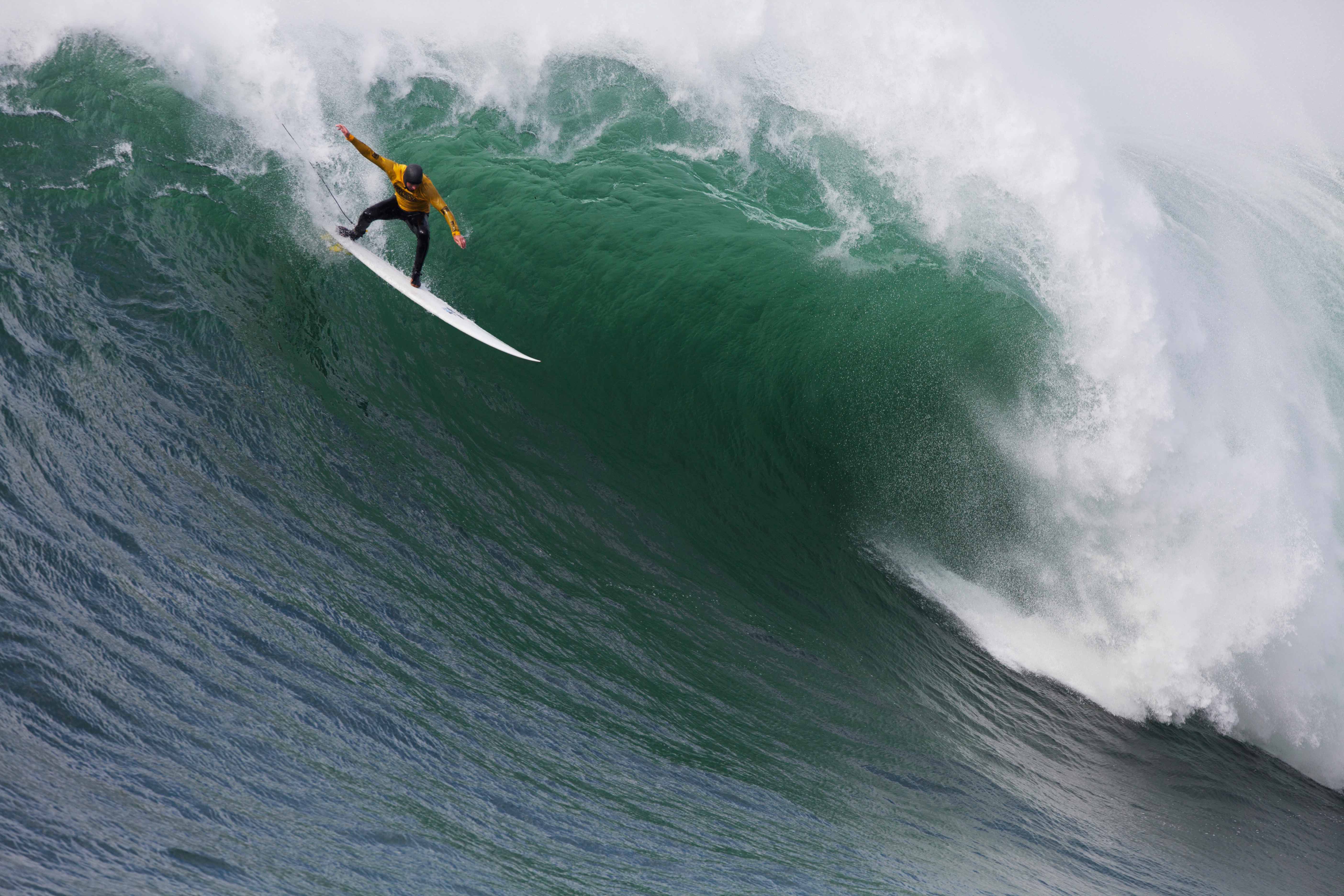How Lucia Griggi chased deadly waves to become one of the world’s best surf photographers
- Text by Nina Zeitman
- Photography by Lucia Griggi // Sarah Lee

It was the biggest day anyone had ever seen at Cloudbreak, the infamous surf spot in Fiji. Fifty-foot waves were crashing down on the reef as the world’s best surfers paddled into the monster swell.
Surf photographer Lucia Griggi was shooting from the back of a jet-ski in the channel. As she and the driver pulled into the lineup to rescue surfer Kala Alexander, a wave hit. Suddenly the jet-ski was flipped upside down. “I remember being dragged over the reef and I couldn’t even keep my head above the amount of whitewater,” she says. “I got pulled back on the ski eventually, but it was awful. I drowned all my camera gear – about ten grand’s worth of kit.”
The day went down in surfing history as the biggest waves ever paddled into at Cloudbreak. It was nicknamed ‘Filthy Friday’.

Close calls are just part of a day’s work for a professional surf photographer like Lucia, but her life wasn’t always spent in the ocean. Growing up between London and Venice, Italy, Lucia was an avid swimmer but she lived hundreds of miles from the nearest beach. While studying for a sports science degree in London, she met a group of surfers who introduced her to the sport. “I didn’t even know what surfing was before I went to university.”
As soon as she handed in her dissertation, Lucia left London to train as a beach lifeguard and surf instructor in Cornwall. The next few years were spent teaching surfing in the summer and travelling to surf spots such as Morocco, Indonesia and Australia in the winter. That’s when photography came into her life. “I wanted to document the places I visited, so I started carrying my dad’s old Nikon film camera with me.”
She quickly discovered a passion not only for capturing surf culture on land, but photographing surfers in the water. The equipment she needed to waterproof her cameras, however, didn’t come cheap. “My first water-housing was like a plastic bag. I think I drowned my first camera in it,” says Lucia, who slowly gathered what it took to turn professional. “It was never anything I went after; it just fell into place.”
Lucia’s first big break came in 2004 when British surf magazine Carve published a shot she had taken at the English National Surfing Championships. From there, she began to get her work published in more magazines and newspapers, eventually landing a job shooting for the World Surf League (formerly known as the ASP Championship Tour).

Surf photography is a niche, male-dominated industry with no clear-cut career path. As one of the few female surf photographers in the world, she had no mentor or guidance. “No one steered me in the right direction; it was quite the opposite. I just learned from my mistakes.” While she never encountered sexism from her male counterparts, she wasn’t encouraged either – if anything, she was met with blank expressions. “I remember swimming out at Pipeline and I definitely got some looks. They didn’t know what to make of me, but I saw everyone else doing it, so I was like, why can’t I?”
As time went on, Lucia gravitated towards shooting surfers in the biggest, gnarliest waves out there – including Pipeline, a notorious wave which breaks onto a sharp, cavernous reef, making it one of the world’s most dangerous. Lucia spent days studying the wave before swimming out for the first time. “Timing is crucial,” she says. “If you don’t swim out at the right time in the right place, you can get caught inside and smashed on the reef. People die at Pipeline.”
It’s physically exhausting, carrying heavy camera equipment in one hand while ducking under waves, clinging on to the reef and swimming for up to four hours at a time. “When the wave hits, it’s like a bomb crashing on top of you,” says Lucia, recalling one occasion when things started to go awry. “I remember seeing the surfer I was shooting looking at me. I could see it in his eyes. I was completely done for.”
Wiping out is not the only danger when tackling tropical reef breaks. Lucia remembers another near-miss while shooting surfers at Frigates Pass, a gnarly wave off the coast of Fiji, which is also a premier shark-diving spot. “The current was strong. The waves jumped to fifteen foot. We had to swim for forty minutes across this deep channel through chummed water. I remember looking down at this massive drop-off into the abyss. There were shadows of sharks swimming beneath. I completely sketched myself out. I was convinced that was the end.”

Another time in the Maldives, Lucia found herself stranded after an electrical storm rolled in and the boat that was meant to carry her ashore never came back. “I was the only one left, bobbing in the water completely alone for two hours into the night while a surfer paddled to get help.”
But where these moments would have put others off, Lucia has always held fear at bay. She now lives in California and continues shooting campaigns for Quiksilver, Nikon, Red Bull and Ford while working on her new book, profiling the top twenty female big-wave surfers, and teaching workshops on water photography.
“Life has a funny way of working out,” she says. “If you really want to do something, it will happen as long as you try hard enough. Photography is everything for me. If I didn’t have it, I don’t think I’d have a purpose. It’s a profession that takes a lifetime to become an expert at. I’m only just starting.”
This article originally appeared in Huck 55 – The Freaked Out Issue. Buy it in the Huck Shop now or subscribe to make sure you never miss another issue.
Enjoyed this article? Like Huck on Facebook or follow us on Twitter.
You might like

Largest-Ever Display of UK AIDS Memorial Quilt Opens at Tate Modern
Grief Made Visible — Comprising hundreds of panels made by lovers, friends and chosen family, the UK AIDS Memorial Quilt returns in full for the first time since 1994 – a testament to grief, friendship and the ongoing fight against HIV stigma.
Written by: Ella Glossop

In Medellín’s alleys and side streets, football’s founding spirit shines
Street Spirit — Granted two weeks of unfettered access, photographer Tom Ringsby captures the warmth and DIY essence of the Colombian city’s grassroots street football scene.
Written by: Isaac Muk

Remembering New York’s ’90s gay scene via its vibrant nightclub flyers
Getting In — After coming out in his 20s, David Kennerley became a fixture on the city’s queer scene, while pocketing invites that he picked up along the way. His latest book dives into his rich archive.
Written by: Miss Rosen

On Alexander Skarsgård’s trousers, The Rehearsal, and the importance of weirdos
Freaks and Finances — In the May edition of our monthly culture newsletter, columnist Emma Garland reflects on the Swedish actor’s Cannes look, Nathan Fielder’s wild ambition, and Jafaican.
Written by: Emma Garland

Dalia Al-Dujaili: “When you’re placeless, nature can fill the void”
Babylon, Albion — As her new book publishes, the British-Iraqi author speaks about connecting with the land as a second-generation migrant, plants as symbols of resistance, and being proud of her parents.
Written by: Zahra Onsori

We are all Mia Khalifa
How humour, therapy and community help Huck's latest cover star control her narrative.
Written by: Alya Mooro

